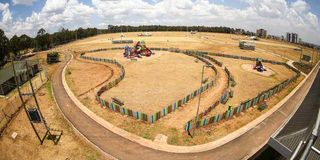Premium
Sh1.2bn was spent on a sports ground that was never used

A fish-eye view of the Jamuhuri Sports Complex on the day it was officially opened by President Uhuru Kenyatta on March 25, 2022.
What you need to know:
- The construction of the 60,000-capacity edifice began on March 1, 2023, and is scheduled for completion in December this year.
- Of the Sh14.2 billion that was transferred from the Sports, Arts, and Social Development Fund to various state agencies, the audit report shows that Sh11.5 billion was wired to various sports federations.
The latest Auditor-General’s report on expenditure in the State Department for Sports has questioned the spending of Sh1.2 billion on the ground where the Talanta Sports City Stadium is being constructed.
The Auditor General Nancy Gathungu has also raised concern over Sh300 million that cannot be accounted for in the Sports, Arts, and Social Development Fund for the year ended June 30, 2024, shortage in both funding and spending, delays in disbursing funds to sports federations, pending bills totalling more than Sh300 million, and lack of an audit committee as required by the law.
Talanta Sports City Stadium which is under construction, is earmarked as a venue for the 2027 Africa Cup of Nations, that Kenya will co-host with Uganda and Tanzania.
The construction of the 60,000-capacity edifice began on March 1, 2023, and is scheduled for completion in December this year.
Gathungu states that a physical audit verification revealed that the project had resulted in the demolition of two football pitches, two restrooms, and access roads that had been constructed earlier.
She adds that the street lights erected on the property were not functioning while the chain link fence built around it had been vandalised.
“In the circumstances, the value for money to be realised from the expenditure of Sh1,200,290,692 could not be confirmed,” notes Gathungu.
Her findings contradict assurances made by former Sports Cabinet Secretary Ababu Namwamba that most of the existing facilities at Jamhuri Posta Ground would remain intact, with the contractor agreeing to relocate some structures within the venue. Namwamba made the promise during the ground-breaking ceremony of the project on March 1, 2023, an event which was presided over by President William Ruto.
The administration of former President Uhuru Kenyatta had initiated the development of the Jamhuri Posta Sports Ground to promote talent growth in the country.
The scope of the work, Gathungu says, included the construction of three football fields, and one rugby pitch as well as access roads and landscaping.
She states that it is unclear whether the Sh300 million that was transferred from the Sports, Arts and Social Development Fund to the Ministry of Health for equipping a Level 4 Hospital in Sololo, Marsabit County was spent appropriately since no expenditure reports were provided. In total, Sh14.2 billion was transferred from the kitty to various government agencies and sports organisations, with Sh1.1 billion of that amount being allocated to social development, including universal health care.
The audit report reveals that while the State Department for Sports’ budget was Sh17.6 billion, it received Sh15.9 billion, leading to a funding shortfall of Sh1.6 billion.
Similarly, the Sports, Arts, and Social Development Fund only received Sh14.6 billion of its Sh16.2 billion budget, resulting in a shortfall of Sh1.4 billion. However, the Fund did not spend Sh260 million.
“The under-funding and under-performance affected the planned activities and may have impacted negatively on service delivery to the public,” says Gathungu in both cases.
Of the Sh14.2 billion that was transferred from the Sports, Arts, and Social Development Fund to various state agencies, the audit report shows that Sh11.5 billion was wired to various sports federations for the promotion and development of sports locally.
However, despite the federations submitting their budget to the State Department of Sports on time, fund disbursements were often delayed, sometimes by up to two months after the events had already taken place.
These delays, Gathungu notes, may have “hindered the planning and implementation of essential operational elements thereby adversely affecting the federation's reputation and the country's ability to host major sporting events”.

